Long before the Snowy Mountains Hydro-Electric Scheme revolutionised non-Anglican migration to Australia in the 1940s and 1950s,another gigantic engineering feat had pioneered the way — the Dr John Bradfield-inspired Sydney Harbour Bridge which celebrates its 90th anniversary this weekend.
“There were 250 employees in Granite Town from 13 nationalities,” says Dr Sophie Loy-Wilson,senior lecturer in Australian history at the University of Sydney.
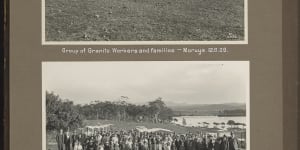
A group of Granite Town workers and residents in 1926. There were 250 employees from 13 nationalities in this now ghost town.Sydney University Library
“Many were Italians and Australians,but the Scots were in charge and set the tone with a Presbyterian service in the school hall every Sunday.”
Search for Granite Town today and you’ll find it a ghost town — three kilometres to the east of Moruya on the north bank of the Moruya river,between Eden and Batemans Bay. A small riverside park with a few information boards is all that marks the site’s rich heritage.
Yet for seven years from 1924-1931,these quarrymen (with their families supporting them) toiled under harsh Australian conditions with one mission.
They carved out each numbered granite block — with Lego-like precision — that could be transported via tramlines to the Moruya wharf. There,they were loaded onto barges carrying them 400 kilometres up the coast to build the four granite towers the world witnesses every New Year’s Eve.
“This was a company town,” Loy-Wilson explains. “Moruya was already known for its superb granite.”
(In Sydney,Captain Cook’s statue and the Anzac Memorial,both in Hyde Park,are carved from Moruya granite.)
After winning the construction contract to build the bridge,the British engineers Dorman Long knew who to call once granite was mentioned.
Aberdeen is known as the “granite capital of Scotland”,its streetscapes as grey and uninviting as the North Sea.
Scot John Gilmore was appointed as quarrymaster,arriving by ship in Sydney with his wife,Mary,and nine children before setting sail again for Moruya.
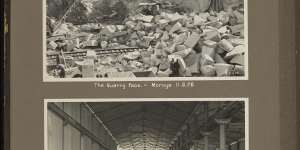
Stonemasons quarried each block at Granite Town to the precise dimensions needed to build the four pillars of the bridge,first at the rock face,then in the shaping shed,before a specially built tramway took the cargo to Moruya wharf.Sydney University Library
“The weather was so bad they had to stay in Bateman’s Bay for a while,” Loy-Wilson says.
They must have wondered what they had committed their family to. But somehow,they helped build a community to be proud of.
“One of the first big problems they faced in Granite Town was the lack of a schoolteacher,” Loy-Wilson says.
By 1927,they had one,a Mrs McIlroy,described by theMoruya Examiner as “the popular mistress at the Granite Town public school”. On September 23,Mrs McIlroy directed her pupils in “a Kinderspiel,Dan the Newsboy” to celebrate the opening of the school’s new hall,followed by a dance.
The previous Sunday,a Mr Allison had conducted the first Presbyterian service in the new hall,with theExaminer reporting that “70 children attend the Sunday School and they all seem anxious for good things”.
By then the community also boasted “the Granite Town Progressive Association”,a recently formed music class,a boys’ club with dancing lessons “which reflects great credit on instructor Mr A Gerrard”,fortnightly whist drives and a co-op that “reports satisfactory dealing despite numerous prophecies of a premature downfall”.
Just as importantly,the stonemasons had built themselves a swimming pool. In January 1927,theExaminer reported the pool was “practically completed and our friends from chilly Scotland frequently take advantage of the pool,to gain respite from the Australian sun. On hot afternoons the pool is taxed to its utmost capacity,old and young alike reveling in its coolness.”
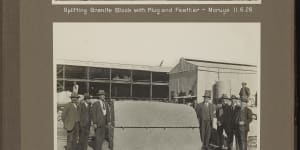
A worker splits the granite block with a plug and feather,a three-piece tool set.Sydney University Library
In contrast to much of rural Australia,Granite Town was booming. At its peak,it consisted of 72 cottages,a bachelors quarters,the school and hall,the co-op and a post office.
Most people date the Great Depression from the Wall Street stock market crash in October 1929. But Loy-Wilson points out that unemployment in Australia rose rapidly from 1927,when chief exports wool,wheat and refrigerated meat drastically dipped in price.
The stonemasons in Granite Town,though,had a secure stream of income.
They quarried each block to the precise dimensions needed to build the four pillars of the bridge — first at the rock face,then in the shaping shed,before a tramway took the precious cargo to Moruya wharf.
Their endeavours,virtually unseen for 90 years,are readily available now. All 596 photos taken by Henri Mallard of “the coathanger’s” construction have been.
Australia’s oldest university has an extensive Bradfield collection (he gained his doctorate while designing the bridge and his son left Bradfield’s personal archives to the university).
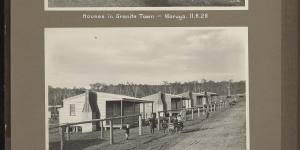
Boom town to ghost town:at its peak Granite Town consisted of 72 cottages,bachelors quarters,a school,hall,a co-op and post office.Sydney University Library
But the university purchased his four albums of Mallard’s photographs only this century. Less than 30 document Granite Town’s contribution to one of the greatest engineering feats of the early 20th century.
“Moruya was already a multi-ethnic town before Granite Town,” explains Chinese-Australian Loy-Wilson,author of 2017’sAustralians in Shanghai,which follows how Australians helped pioneer the “China trade” from Shanghai and Hong Kong to Sydney and Melbourne.
“Many Chinese miners who rushed to Australia’s goldfields became fishermen in Moruya,” Loy-Wilson continues.
She does not know where the founders and children of Granite Town ended up once the last granite stone was sent to Sydney and Granite Town was shut down in 1931.
“Dorman Long had committed to paying return shipping fares for anyone who came out from the UK,” Loy-Wilson says.
But this was during the Great Depression,when the White Australia policy was still rife,and Australia’s swimming pools were more enticing than a brisk paddle at Aberdeen’s “beach promenade”.
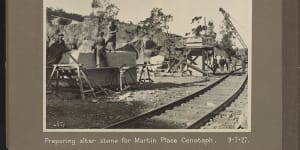
Preparing an altar stone for the Martin Place Cenotaph in 1927. Granite from Moruya was used for the Captain Cook statue and the Anzac Memorial in Hyde Park.Sydney University Library
It’s commonly thought most Granite Town families stayed in Australia.
Perhaps they watch the annual global extravaganza that is Sydney’s NYE fireworks and stifle a smirk.
Some 18,000 cubic metres of granite blocks were individually hewn and carved at Granite Town. Each one is useless in engineering terms,serving no purpose to solidify the bridge’s stability.
As anyone who has completed Bridgeclimb will know,the steel structure of the Sydney Harbour Bridge is entirely self-supporting.
The granite pylons were added purely for decoration — and to counter complaints from critics (including letter writers to the SMH) that no bridge so ambitious in its span could bear the load without granite supports.
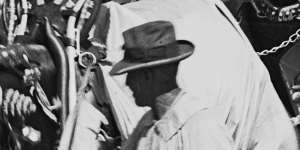
The finished product:crowds watch on during the opening celebrations for the Sydney Harbour Bridge on March 19,1932.NLA
The Morning Edition newsletter is our guide to the day’s most important and interesting stories,analysis and insights..